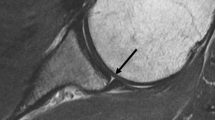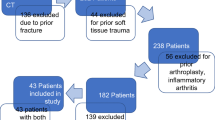Abstract
Our purpose was to try to apply a CT classification of glenoid rim shapes to MR images and to determine the reliability of the subsequent MR classification by testing observer variability. Shoulder MR imaging exams of 54 consecutive patients were reviewed retrospectively by two musculoskeletal radiologists independently. Posterior-inferior glenoid rim shape was categorized, based on reported CT criteria, as triangle, “lazy-J” or “delta” using the most caudal MR section that unequivocally showed articular cartilage. The same studies were reviewed again one month later to test interobserver and intraobserver variability. Final determination of glenoid rim type was made by consensus. There were 31 males and 23 females with an average age of 42 years, range 14–75 years. Forty-one patients were referred for evaluation of nonspecific shoulder pain, 9 for suspected rotator cuff tear and 4 for instability. The most common shape was “lazy-J” with 32 patients (59%) having this type. The least common was delta shape, with 7 patients (13%) having this form. Fifteen patients (28%) had a normal triangle shape. There was significant interobserver variability in determining the shape of the glenoid rim with 17/54 (31%) discordant readings. For the “lazy-J” shape, the kappa value was .02, for the “delta” type, kappa value was .60 and for the triangle shape, kappa was .32. Intraobserver variability was 35% for radiologist A and 28% for radiologist B. Kappa values for intraobserver variability ranged from .53 to .85. Four patients had posterior instability, 3 were judged to have normal triangular inferior glenoid rims and 1 a “lazy J” type by Radiologist A. Radiologist B judged 2 of the instability patients as normal triangular and 2 as “lazy J”. A CT classification of posterior-inferior glenoid rim shapes can be applied using MR imaging, however, there is significant observer variability that limits the applicability of this classification scheme with MR imaging.




Similar content being viewed by others
References
Antoniou J, Harryman DT (2001) Posterior instability. Orthop Clin North Am 32:463–473
Bigliani LU, Pollock RG, McIlveen SJ et al (1995) Shift of posteriorinferior aspect of capsule for recurrent posterior glenohumeral instability. J Bone Joint Surg Am 77:1011–1019
Edelson JG (1995) Localized glenoid hypoplasia. Clin Orthop 321:189–195
Fleiss JL (1981) Statistical methods for rates and proportions, 2nd edn. Wiley, Hoboken
Fronek J, Warre RF, Bowen M (1989) Posterior subluxation of the glenohumeral joint. J Bone Joint Surg Am 71:205–216
Gerber C, Ganz R, Vinh TS (1987) Glenoplasty for recurrent posterior instability. Clin Orthop 216:70–79
Hawkins RJ, Koppert G, Johnston G (1984) Recurrent posterior instability (subluxation) of the shoulder. J Bone Joint Surg Am 66:169–174
Inui H, Sugamoto K, Miyamoto T et al (2002) Glenoid shape in atraumatic posterior instability of the shoulder. Clin Orthop 403:87–92
Landis JR, Koch GG (1977) The measurement of observer agreement for categorical data. Biometrics 33:159–174
Metcalf MH, Duckworth DG, Lee SB et al (1999) Posteroinferior glenoplasty can change glenoid shape and increase the mechanical stability of the shoulder. J Shoulder Elbow Surg 8:205–213
Trout TE, Resnick D (1996) Glenoid hypoplasia and its relationship to instability. Skeletal Radiol 25:37–40
Weishaupt D, Zanetti M., Nyffeler RW et al (2000) Posterior glenoid rim deficiency in recurrent (atraumatic) posterior shoulder instability. Skeletal Radiol 29:204–210
De Wilde LF, Berghs BM, Audenaert E et al (2004) About the variability of the shape of the glenoid cavity. Surg Radiol Anat 26:54–59
Acknowledgements
We thank Dr. Frank Hooper for his help with the statistical analyses. This study complies with our institutional review board policies.
Author information
Authors and Affiliations
Corresponding author
Rights and permissions
About this article
Cite this article
Mulligan, M.E., Pontius, C.S. Posterior-inferior glenoid rim shapes by MR imaging. Surg Radiol Anat 27, 336–339 (2005). https://doi.org/10.1007/s00276-005-0330-y
Received:
Accepted:
Published:
Issue Date:
DOI: https://doi.org/10.1007/s00276-005-0330-y




